Philips OLED769 is the entry-level OLED model from the Dutch manufacturer for 2024, but don’t let that mislead you. OLED769 surprises with its image quality and several interesting features. Thanks to OLED technology, the colours are truly vivid, and the contrast is very good – deep blacks and bright highlights displayed on this screen make a difference, especially when watching evening series. When it comes to motion fluidity, OLED769 performs really well. The 120 Hz panel handles dynamic scenes excellently, whether it's sports or games. When it comes to gaming on consoles, the television does not disappoint either – 4 HDMI 2.1 ports support VRR and ALLM, and the fast response time ensures smooth and responsive gameplay. And what about Ambilight? It’s a classic Philips feature and one of those functions that either you love or hate. In this model, it works very well – the backlighting responds to the content on the screen and adds atmosphere, particularly in a dark room. It’s not something that everyone will consider essential, but it does make an impression in the evenings – at least on us. As for the new operating system TitanOS, it leaves us with mixed feelings. It operates quickly, but some popular applications are missing. For more demanding users, it might lack the flexibility that earlier Philips systems (GoogleTV) offered. Philips OLED769 is a good choice for those looking for a television with beautiful image quality and the exceptional addition of Ambilight. The image quality and motion fluidity will satisfy most users, and the minor limitations of the operating system will not be a hindrance if you prioritise basic applications. It’s a solid option for both watching films and gaming.
- Matching (Score)
- Our verdict
- TV appearance
- Where to buy
- Contrast and black detail
- HDR effect quality
- Factory color reproduction
- Color reproduction after calibration
- Smoothness of tonal transitions
- Image scaling and smoothness of tonal transitions
- Blur and motion smoothness
- Console compatibility and gaming features
- Input lag
- Compatibility with PC
- Viewing angles
- TV efficiency during daytime
- Details about the matrix
- TV features
- Apps
- Playing files from USB
- Sound
Philips OLED769 vs TCL C7K / QM7K
Direct compare
OLED769 / AMIBLIGHT TV
C7K / Q7C / MQLED85K / C79K / C71K / QM7K

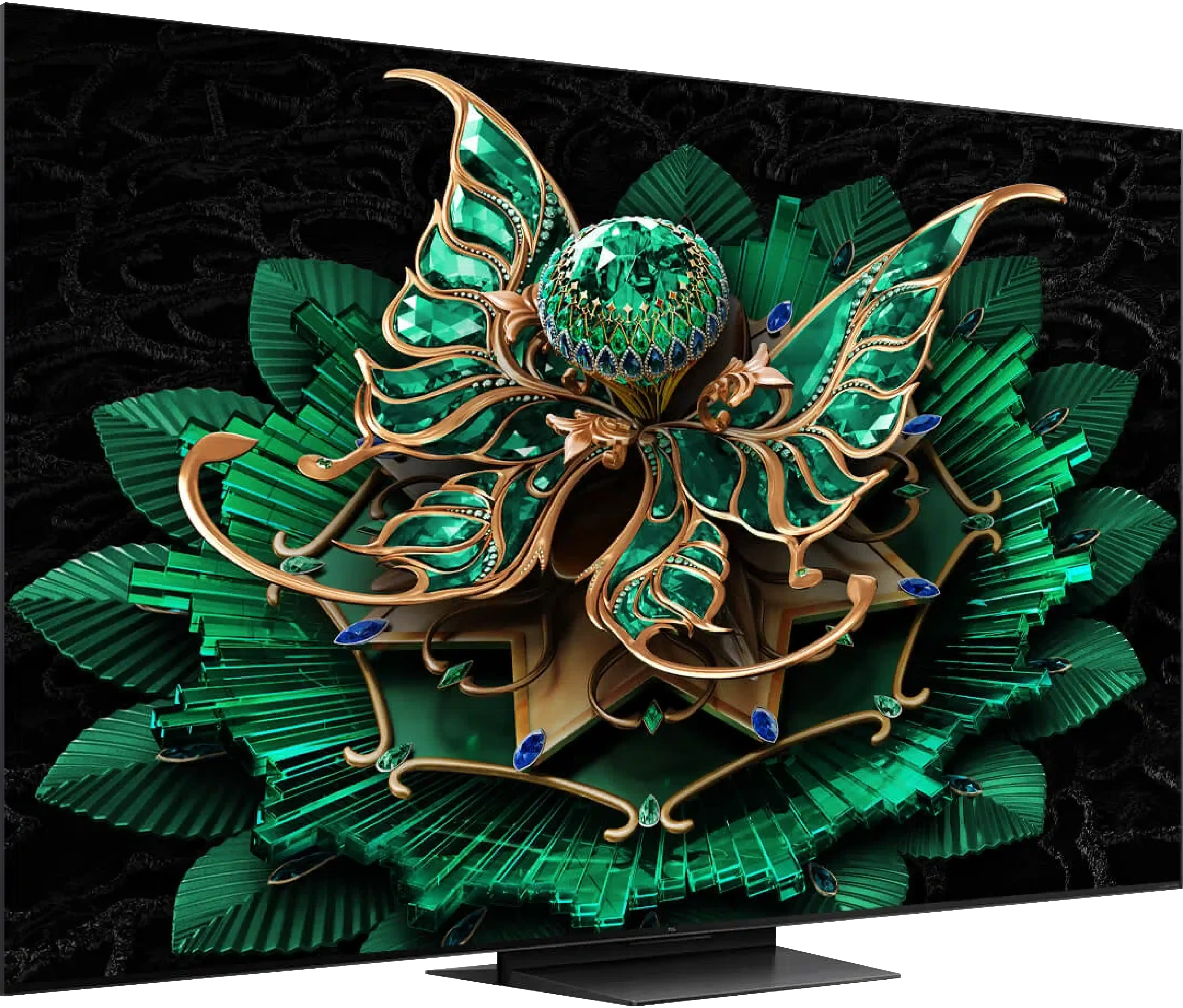
Panel type: WRGB OLED
Resolution: 3840x2160
System: Titan OS
Model year: 2024
Complete the survey to find out the result

Panel type: LCD VA
Resolution: 3840x2160
System: Google TV
Model year: 2025
Complete the survey to find out the result

Overall rating
7.3
7.1
Movies and series in UHD quality
7.7
6.7
Classic TV, YouTube
8.4
6.5
Sports broadcasts (TV and apps)
8.3
6.4
Gaming on console
9.2
8.5
TV as a computer monitor
7.6
8.4
Watching in bright light
4.6
6.1
Utility functions
5.5
7.7
Apps
6.2
9.6
Sound quality
6.7
7.0
Complete the survey to find out what fits your preferences
Advantages
Great contrast
Perfect choice for gamers and sports - HDMI 2.1, 120Hz, low input lag
3-sided Ambilight system
Excellent colour reproduction after calibration
Very good black - VA panel with a large number of Mini-LED zones
High brightness in HDR - over 1000 nits
Excellent for gamers - HDMI 2.1, low input lag, VRR, ALLM, etc.
Good motion smoothness - 144Hz panel
Supports multiple HDR formats: HDR10, HDR10+, Dolby Vision
Google TV operating system with access to a vast array of applications
Pleasant sound from built-in speakers
Disadvantages
Poorly developed operating system - TitanOS
Average brightness
Google TV can operate with minor stutters
No USB recording and PiP functionality
Our verdict
There are televisions that come for testing, and you immediately think: “oh, just another average one, probably like many others.” And basically… that’s true. The TCL C7K doesn’t try to dethrone OLEDs, nor does it shout from the box “revolution!” Yet, after a few days of testing, it’s hard not to think: “wow, this is really good equipment.” And that’s exactly what the C7K is. The biggest asset of the C7K is its decent picture at a reasonable price – MiniLED and quantum dots do their job here. The colours are vibrant, the brightness satisfactory, the contrast impressive, and with the right settings, you can truly enjoy viewing in the best quality. The second strong point is the smoothness of motion – both in sports and games. Support for HDMI 2.1, variable refresh rates, 144 Hz, and a whole host of other features make gaming on this TV a pure joy. Then there’s Google TV, which – despite some minor shortcomings – provides access to nearly an endless library of applications. Voice control, quick access to YouTube, Netflix, AirPlay support – it has everything you need for everyday use. Are there downsides? Of course. The Google TV system can have moments of “hesitation,” and MiniLED – being MiniLED – can stumble on very complex film scenes. But these are details. After all, the C7K is a mid-range model – and in this class, it performs simply excellently. So if you are looking for a reasonably priced, modern television with Google TV that looks good, works well, and plays quite decently without ruining your budget – the TCL C7K definitely deserves your attention.
TV appearance

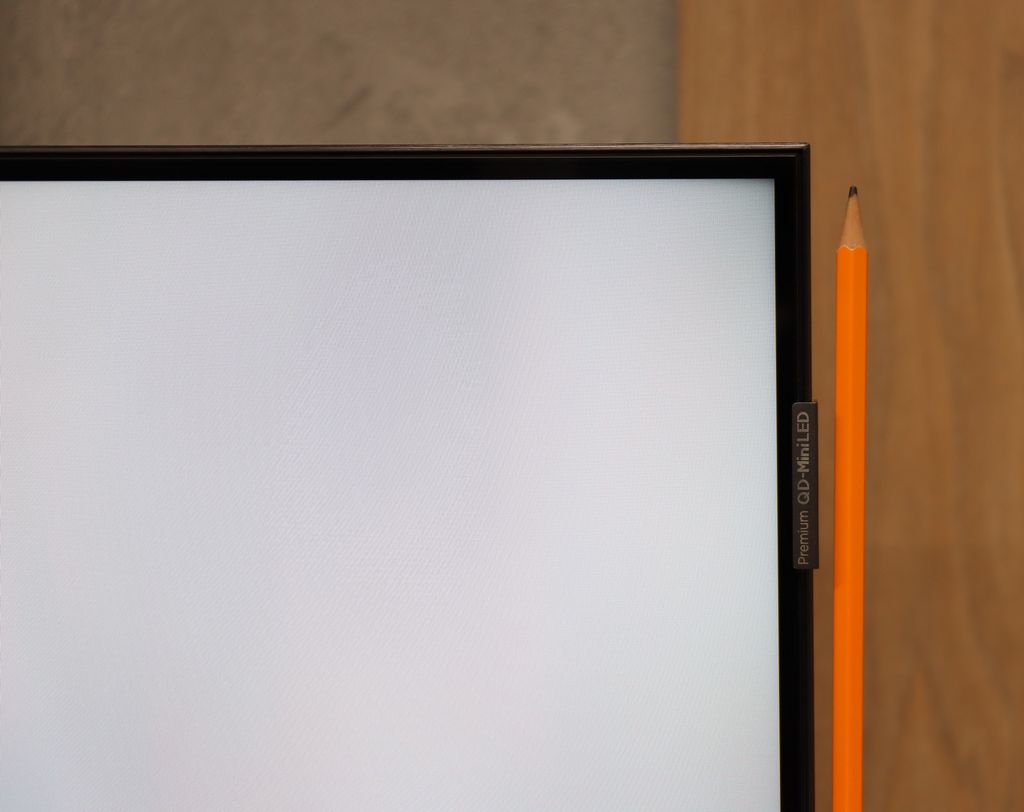
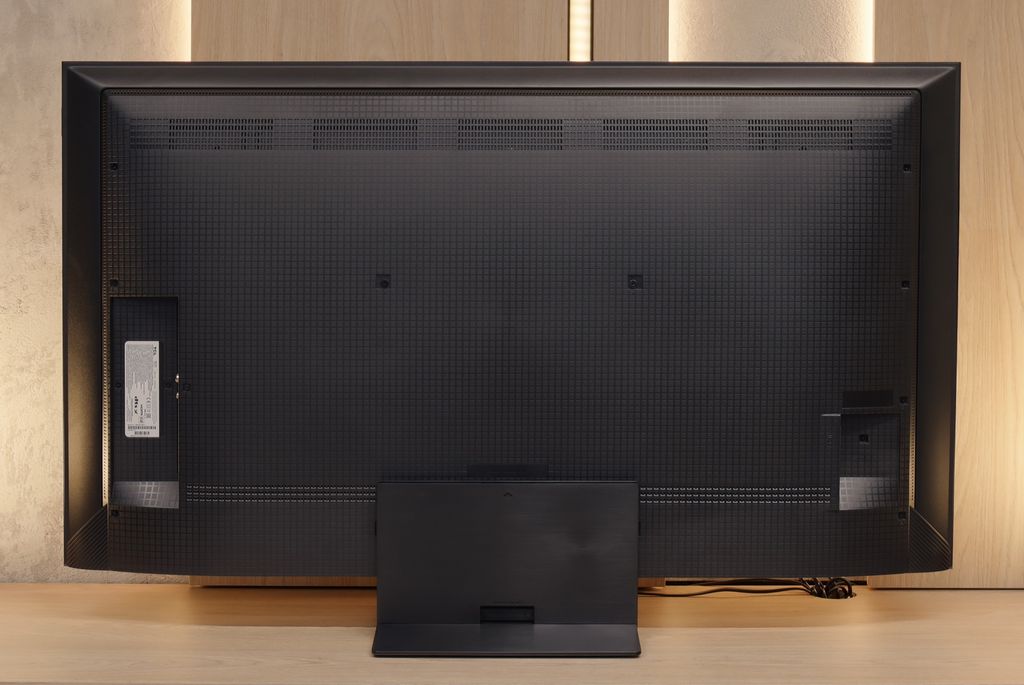
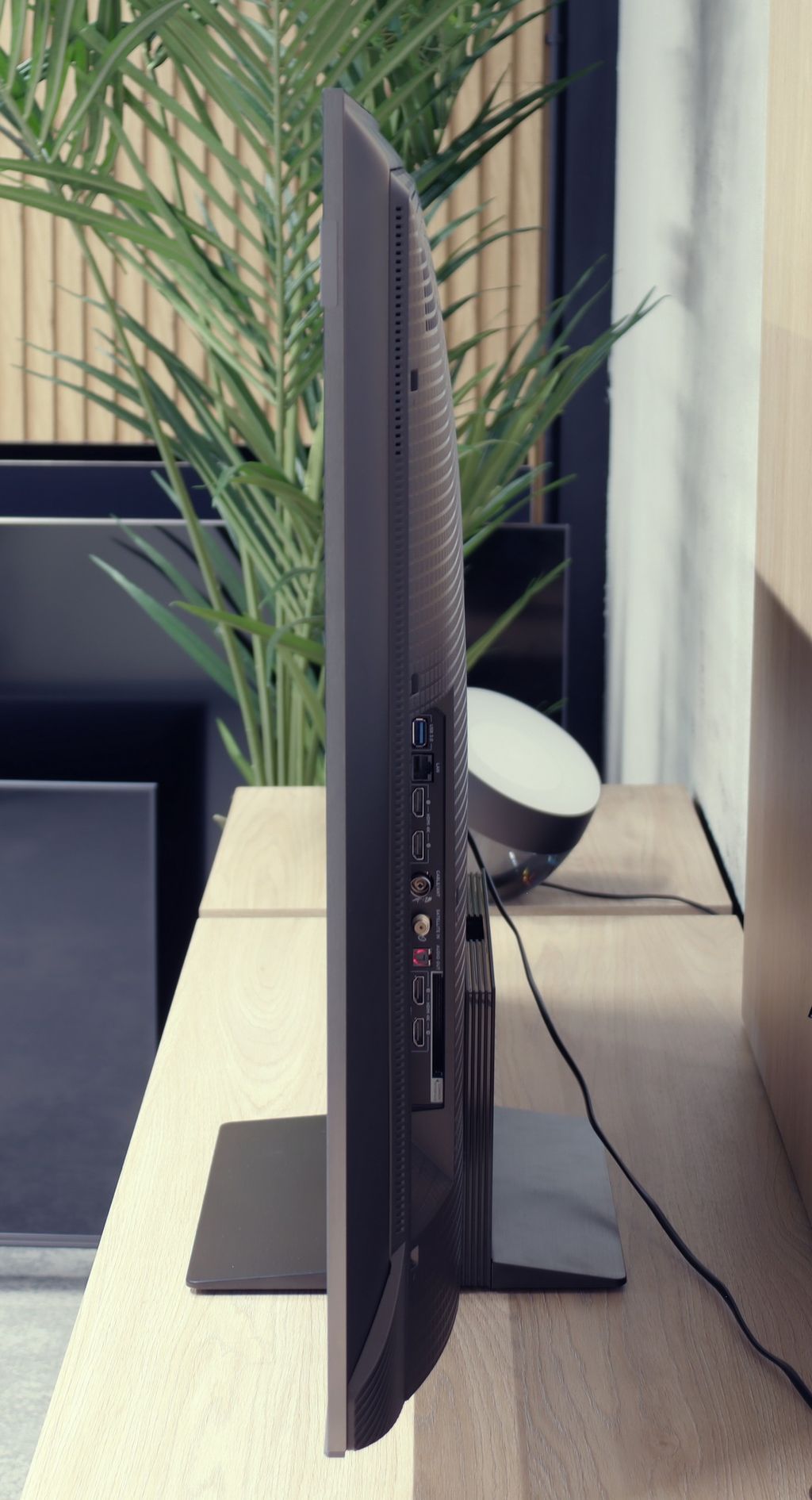
Contrast and black detail
10/10
7.1/10
Local dimming function: Yes, number of zones: 336 (14 x 24)
Contrast:

Result
∞:1

Result
∞:1

Result
∞:1

Result
∞:1

Result
∞:1

Result
161,000:1

Result
18,750:1

Result
13,150:1

Result
6,300:1

Result
4,200:1
Halo effect and black detail visibility:

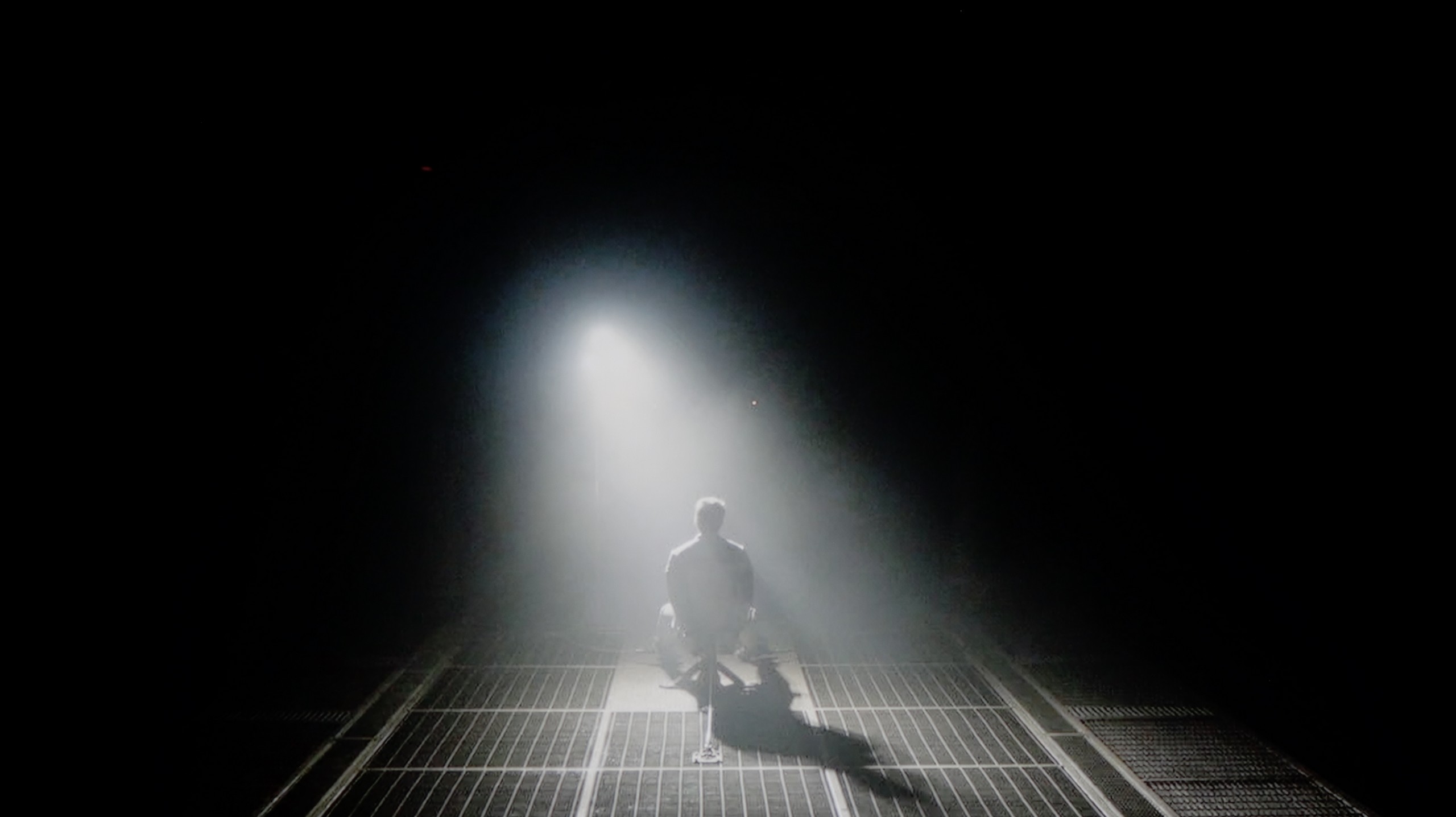
Philips OLED769 impresses with its black levels and contrast. Thanks to OLED technology, each pixel in this television is self-illuminating, allowing for the complete shutdown of individual pixels. This means that black areas of the image are pitch black, and the contrast is infinite. The effect is incredibly realistic, with excellent clarity and detail in dark scenes. The OLED panel used in Philips OLED769 is produced by LG, known as WOLED, ensuring the highest quality in black reproduction. As a result, the television offers a contrast that is unattainable for traditional LCD televisions - even the best ones on the market.
The 50-inch TCL C7K that we tested surprised us right from the start – it’s the smallest model in the series, yet it comes equipped with a VA panel with MiniLED backlighting and – attention – as many as 336 dimming zones. For comparison: many significantly larger televisions from higher tiers would be eager to boast such a number. Here we have it in the 50-inch version. Sounds promising, doesn’t it? So how does this translate into real movie-watching experiences? In the vast majority of tested scenes – very well. The contrast was high enough that it reached even six-digit values in measurements, which practically means very deep blacks and well-separated highlights. In scenes from films like The Revenant or Oblivion, the effect was impressive, matching the best LCD screens in this class.
However, not everything went perfectly. Despite the impressive number of zones, managing them was not always exemplary. In more complex scenes, where small light sources or a high level of detail appeared, the television had issues with the so-called halo effect (a glowing halo around bright objects) or overly aggressive dimming of the image. In such situations, contrast could either collapse due to overexposure of certain zones or, conversely – details in bright areas disappeared because the zones suppressed the light too much. Nonetheless, it is worth noting that in the vast majority of scenes, the contrast was more than satisfactory. And taking into account the size of the television and the price, the final effect will satisfy not just average users.
HDR effect quality
6.1/10
5.4/10
Luminance measurements in HDR:

Result
609 nit

Result
707 nit

Result
801 nit

Result
775 nit

Result
261 nit

Result
1051 nit

Result
185 nit

Result
454 nit

Result
200 nit

Result
836 nit
Scene from the movie “Pan” (about 2800 nits)


Scene from the movie “Billy Lynn” (about 1100 nits)


Static HDR10


Dynamic: Dolby Vision
Dynamic: Dolby Vision


HDR luminance chart:
TCL C7K / QM7K
Luminancja HDR
Luminance of RGB colors
Philips OLED769
Luminancja HDR
Luminance of RGB colors
Philips OLED769 performs quite well, particularly in film scenes with small points of light. The television surprises with its brightness, reaching around 800 nits, which is an impressive result. As a result, fine sources of light, such as street lamps at night or stars in the sky, are sharp and full of detail. However, the biggest challenge for this model is the scene with a full-screen burst of sunlight. In such moments, the brightness drops to about 250 nits, which is not very impressive. This is a typical problem for cheaper OLED displays, which struggle to maintain high brightness across the entire screen surface.
TCL C7K is one of the brightest MiniLED televisions in its price range. Under the best testing conditions, the screen managed to achieve over 1200 nits, resulting in impressive, at times almost blindingly bright scenes. And most importantly – this is not just a theory based on measurements. In practice, the brightest parts of films can shine with true cinematic grandeur. Fans of home HDR cinema should be truly satisfied.
The impression is excellent, especially in scenes with large areas of brightness – a white sky, explosions, sun reflections, or magical sunsets can surprise with an intensity of light that is rarely seen in this price range.
However, it gets a bit worse when more challenging scenarios appear on the screen, as described when discussing contrast – that is, images full of details, with small, bright elements on a dark background. In such cases, the C7K often decides to preserve black levels at the expense of brightness. An example? Scenes from the films Sicario 2 or Life of Pi, where small light sources (like a distant lantern) can become less visible, and details in the lights are simply dimmed or blend into the background.
For many viewers, this may be an acceptable compromise – as we achieve deep black levels and a pleasing plasticity of the image. Nevertheless, it is worth being aware that the visibility of small details in bright areas is not this model's strongest suit. It is simply a technological limitation that still exists – even with over 300 zones.
Factory color reproduction
6.4/10
6/10


Factory Mode
After calibration
The "Film" mode proved to be the best factory setting in terms of fidelity to the source material, and it is on this that we based our tests. However, like other factory modes, it was not without flaws. Let us examine, therefore, what exactly went wrong in SDR and HDR materials.
In both cases, the white balance was disrupted by the excessive dominance of green and red hues. This phenomenon created a yellowish tint that spread across the entire image, leading to issues such as yellowed whites and unnatural skin tones. These problems were clearly highlighted on the "ColourChecker" palette, where each of the samples was shifted towards warmer tones.
As for contrast and brightness, in the Philips OLED769, we can look at two key graphs: Gamma for HD content and the EOTF curve for 4K HDR content. In the case of the first graph, the gamma value falls below the optimal level of 2.4, resulting in an increase in brightness of light areas of the image. This means that bright elements may be slightly overexposed, losing detail and depth. In contrast, the EOTF curve for 4K HDR content performs really well. The graph shows that the television effectively conveys details in both the brightest and darkest areas of the image, resulting in a realistic and dynamic representation of scenes.
A new feature in TCL televisions for 2025 is the long-awaited Filmmaker mode, which until now has been found in most competing brands. This is great news, as this mode is considered to be the truest to the original vision of the creators and is often recommended by enthusiasts of good picture quality. Unfortunately, as is often the case, the mere presence of this mode does not guarantee perfection. The Filmmaker mode in the TCL C7K is not without its flaws. There can be criticism of the incorrect white balance, particularly a slight dominance of blue, which resulted in cool, somewhat greyish skin tones. But that was not the biggest issue. The main complaint was the excessive brightness exposure, which is clearly visible on the gamma and EOTF graphs. The image was simply too bright, at times even blown out, which affected not only the texture of scenes but also the overall viewing experience. Some details were simply lost, and the entire image looked as if someone had slightly overcooked the brightness slider. As always, we decided to check what could be extracted from this after calibration. And that’s where it started to get really interesting…
Color reproduction after calibration
8.8/10
7.5/10




After professional calibration, Philips OLED769 truly shines in terms of colour accuracy. The television has been completely stripped of any yellow tint in both HD and 4K content. The Colour Checker test confirms that deltaE errors are minimal, occasionally exceeding a value of 2, which means we can speak of almost perfect director's representation.
When it comes to contrast, the situation is equally impressive. With 4K materials, there wasn't much to improve initially, while the gamma chart has been significantly enhanced. This allows dark and light areas of the image to be represented with greater accuracy, resulting in a realistic and dynamic portrayal of scenes.
The calibration has allowed the full potential of this television to be unleashed, both in terms of colours and contrast. Philips OLED769 now offers vivid, natural images of high quality that will delight any user, whether they are watching films or using other multimedia.
After calibration, the TCL C7K showcased itself in a really good light, especially when it comes to SDR content. We managed to precisely tune the white balance, colour gamut, and brightness characteristics to the point that colour errors on the ColorChecker palette dropped below a value of 2. For the uninitiated – this is nearly a perfect result, which means that the image is very close to what the creators intended. Unfortunately, the situation was worse with 4K HDR content. Although we managed to gently stabilize the white balance and correct its previous errors, it was still evident that the television has certain "MiniLED traits," especially in brightness management. When we checked how the C7K handled the EOTF curve on actual film scenes, rather than just on synthetic test patterns, it turned out that the screen still tends to slightly brighten the entire image. This impacts the overall experience – blacks lose some depth, and the image becomes less contrasty than it should be. Despite these minor shortcomings in HDR content, the overall reception of materials – especially in SDR – is truly very good. After calibration, the C7K can display an image that can compete successfully with much more expensive models. Good colour tuning, natural skin tones, and pleasant brightness make movie sessions and everyday viewing of content more than satisfactory.
Smoothness of tonal transitions
5.9/10
8.6/10












The gradation in Philips OLED769 unfortunately proves problematic in almost every scene from the test sequence. Particular difficulties arise in dark colours and around black. In these areas, in addition to the posterisation effect, the image is enhanced by a solid dose of noise. The problem with tonal transitions is not limited to dark hues – it can also be seen in lighter elements, such as in a scene from the film "Kingsman," where clear colour banding is visible around the sun. This phenomenon can significantly affect the visual perception, especially in scenes where black and dark shades play a key role. It's hard not to notice these imperfections, which can disrupt the viewing experience, particularly for viewers who value excellent image quality.
The TCL C7K handles colour gradation very well – in most of the tested scenes, tonal transitions were smooth, and colours blended together without visible outlines or the artificial "blot" effect. In everyday use, it's hard to find anything to criticise – the picture looks natural, without annoying transitions or digital artifacts. Certain limitations only arise in very dark tones – particularly in a heavily muted grey palette, where the television may struggle to reproduce the ideal gradation. But this is absolutely understandable, as even many significantly more expensive models in this regard simply falter. Fortunately, these situations are rare and do not significantly impact the overall impression.
Image scaling and smoothness of tonal transitions
7.2/10
5.5/10
Smooth transition function


Image without overscan on the SD signal


When it comes to lower quality materials, the distortion reduction in the Philips OLED769 handles tonal transitions well, especially at the minimum setting. It is worth noting that at this setting, film grain is not blurred, which is a pleasant surprise, as such negative phenomena often occur with other manufacturers. Overall, it is quite a decent solution. However, it should be pointed out that this setting does not work in HDR mode, where gradation issues are much more pronounced. In HDR mode, the television struggles with smoothing tonal transitions and may present more noticeable distortions and noise, reducing picture quality in dynamic scenes.
Regarding digital processing, the Philips OLED769 performs well. The model in the photo is not overly jagged, and the branches in the background lack the characteristic jagged edges. The television achieves this effect thanks to the absence of artificial sharpness, which may be an advantage for some users. Others, however, may find this less attractive, as they prefer a more vibrant, sharper image instead of a subtle effect. This effect can be mitigated by using a higher setting for the "Sharpness" parameter.
TCL C7K is equipped with a feature that, according to the manufacturer, is meant to smooth out unwanted colour transitions – a sort of rescue for less successful tonal shifts. It is called "Gradual Smoothing" and… well, it sounds ambitious, but in practice it works very poorly. Regardless of whether we set it to a low or high level, the difference is minimal. Worst of all, the feature can cut out elements from the picture that should be there. Fortunately, film grain remains untouched, so at least it doesn’t smooth everything indiscriminately, but still – it’s better to simply turn this option off.
When it comes to scaling lower resolution content, it is somewhat better. SD and HD materials look quite decent, although at times we had the impression that the image loses sharpness and becomes too soft – as if something took away its definition. Fortunately, with very low sources (e.g. 576p), there was no overscan effect, meaning the picture was not artificially cropped – everything fit on the screen as it should.
Blur and motion smoothness
8.3/10
7.5/10

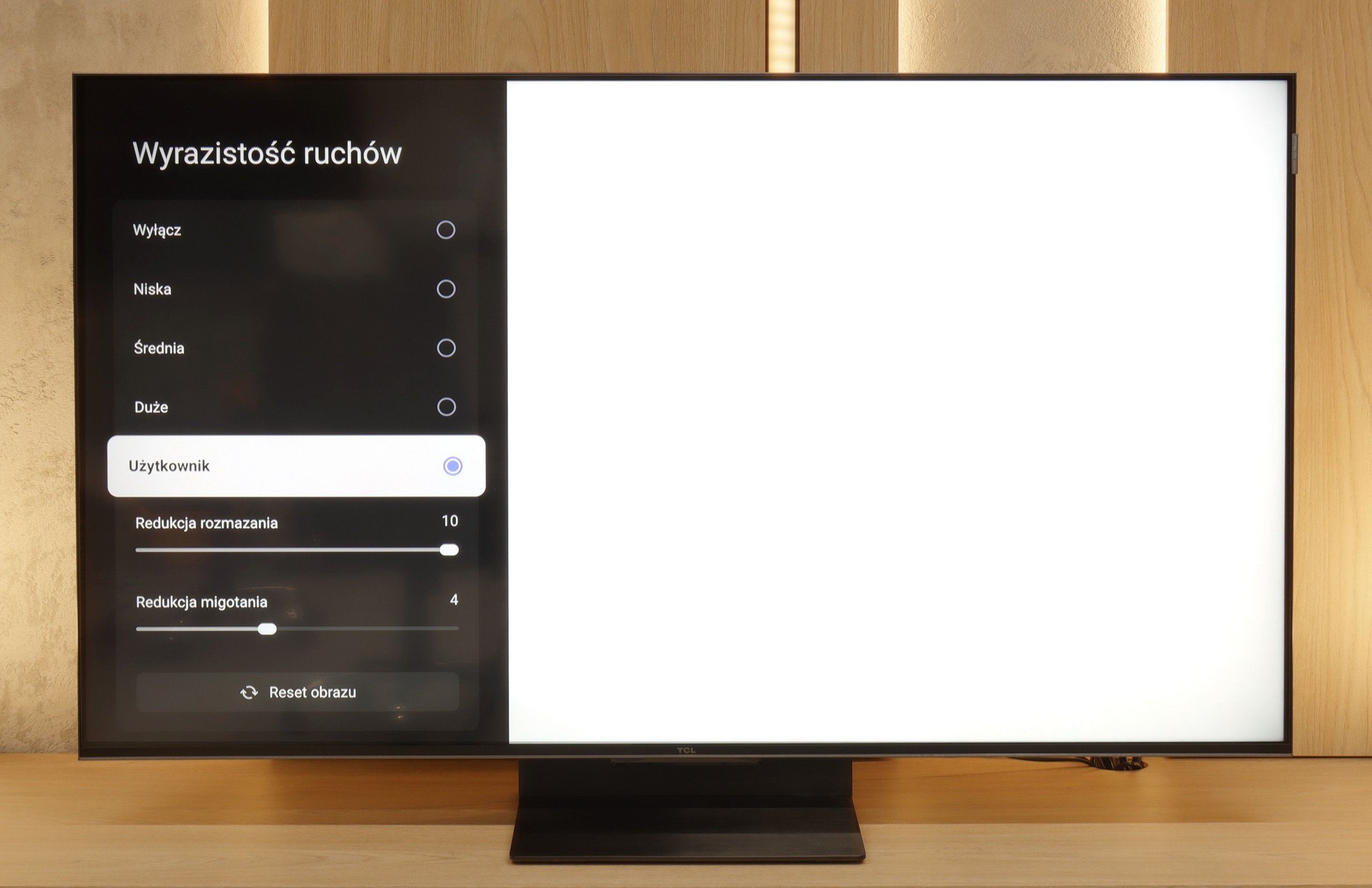
Blur (native resolution, maximum refresh rate):






Blur (BFI function enabled):



Smużenie ():
Smużenie (4K 144Hz):



Philips OLED769 features a multi-stage motion smoother called "Motion Style", which will satisfy users who appreciate the ability to customise the fluidity of motion in films. With this function, you can set the image to be more frame-like or smooth, resembling a theatrical effect. This is a great solution for those who want to adapt the displayed content to their visual preferences. Gamers will also not be disappointed, as the television, like most OLEDs, is equipped with a 120Hz panel. This provides exceptional fluidity and dynamism of the image. Unfortunately, Philips OLED769 does not have the BFI (Black Frame Insertion) feature, which could further improve motion fluidity and sharpness. Despite this limitation, the television still offers excellent visual experiences for both cinema lovers and gamers. This is definitely one of its strong points.
The TCL C7K handles motion fluidity really very well. The matrix used in it offers a refresh rate of 144 Hz, which in itself suggests that this television is more than just a regular "60 Hz" panel. Furthermore – if we connect the C7K to a computer and set the resolution to Full HD. But we'll write more about this in the paragraph about gamers and PC collaboration. Returning to everyday use – both sports and films look very good here. Thanks to the fast panel and well-functioning motion smoothing, the C7K is great for watching matches, but also for movie screenings. In the menu, we find two sliders – motion blur reduction and flicker reduction – which allow us to adjust the fluidity effect to our own preferences. At lower settings, we get a more cinematic effect, with slight stuttering motion. At higher settings – the picture becomes more theatrical, fluid to the point of excess. Everyone has their own preferences – anyone can set it to their liking.
Console compatibility and gaming features
10/10
9.8/10
- ALLM
- VRR
- VRR range40 - 120Hz48 - 144Hz
- Dolby Vision Game Mode
- Correct implementation of HGIG
- 1080p@120Hz
- 1440p@120Hz
- 4K@120Hz
- Game bar

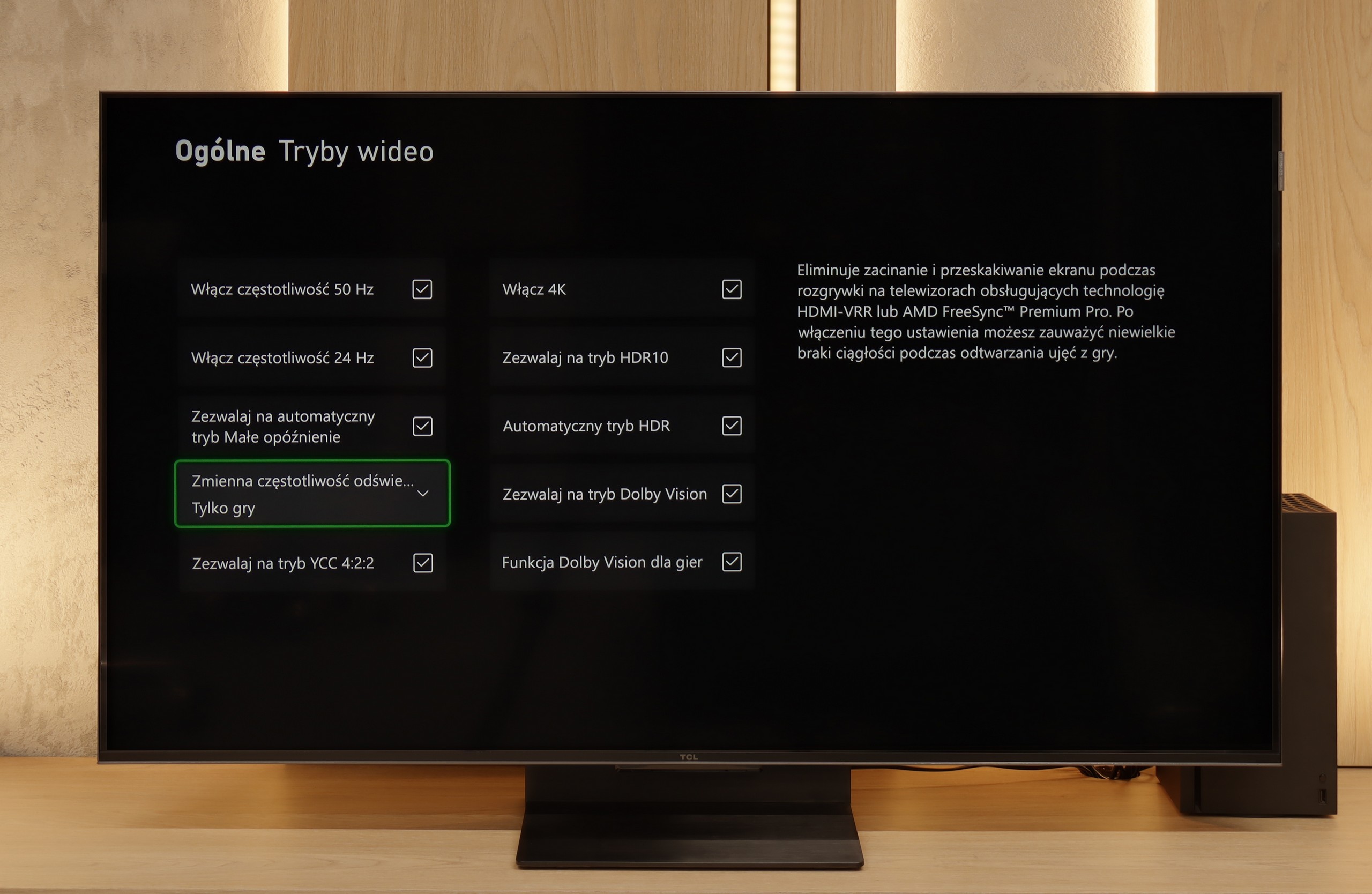

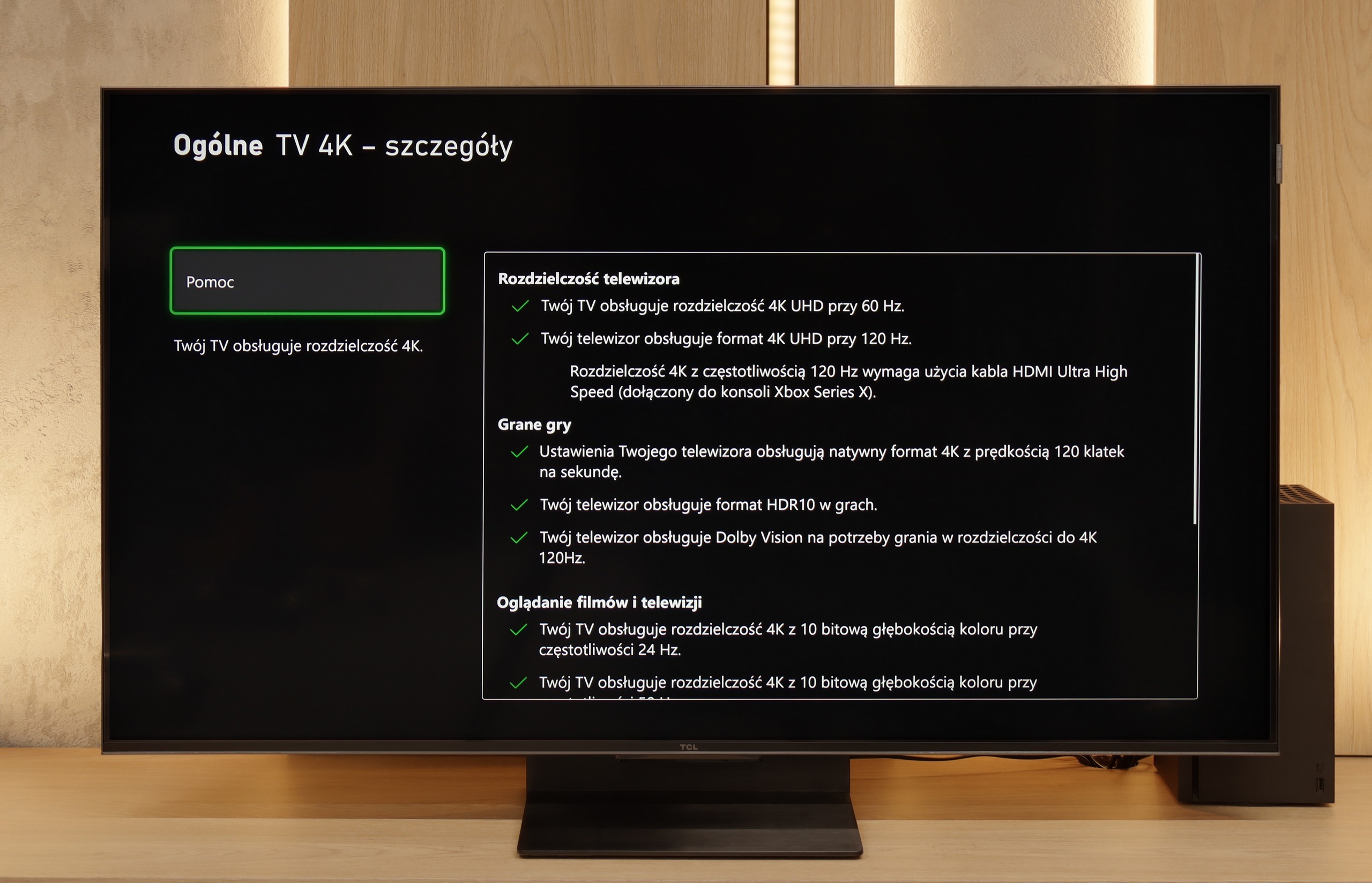

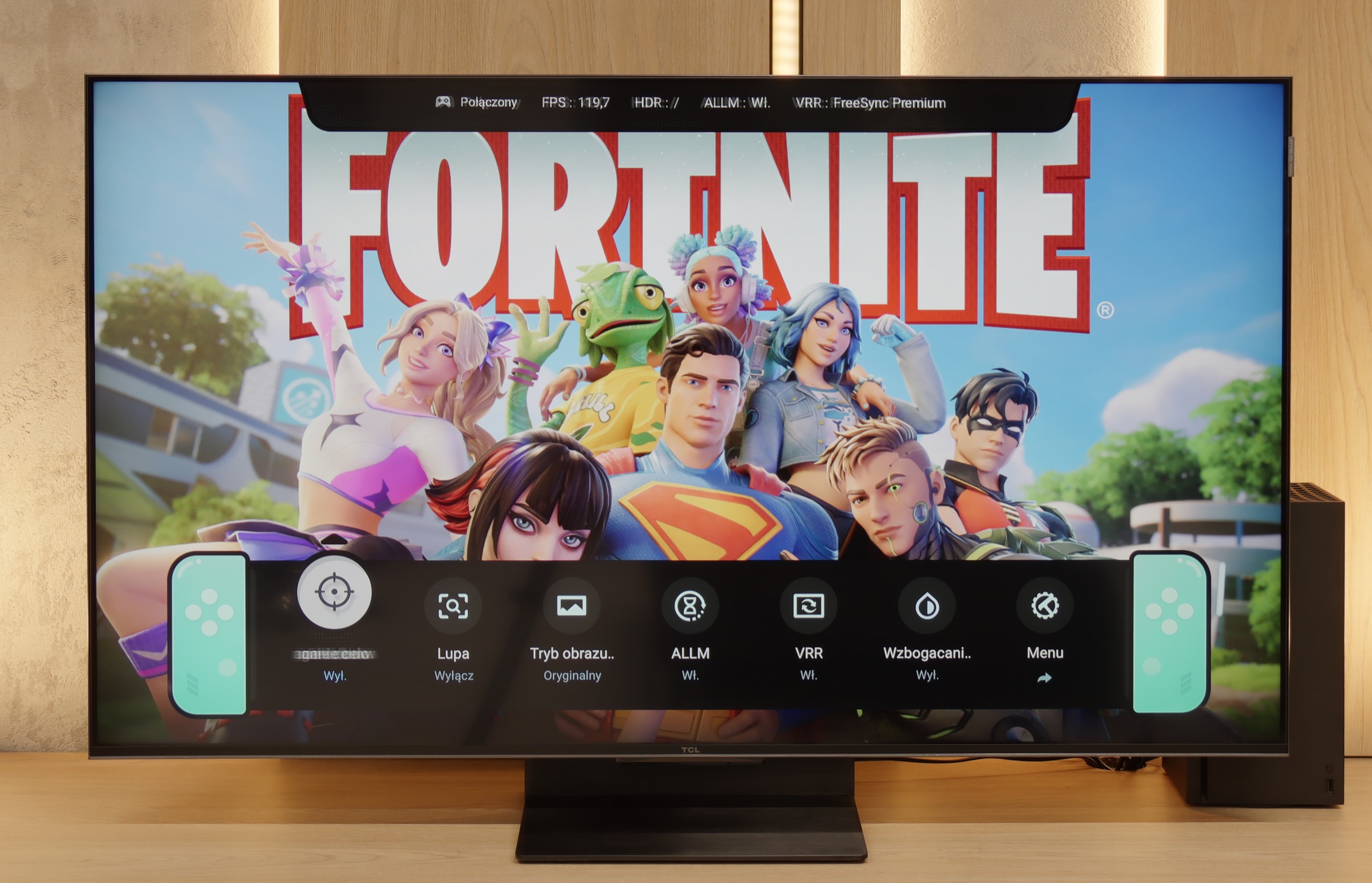

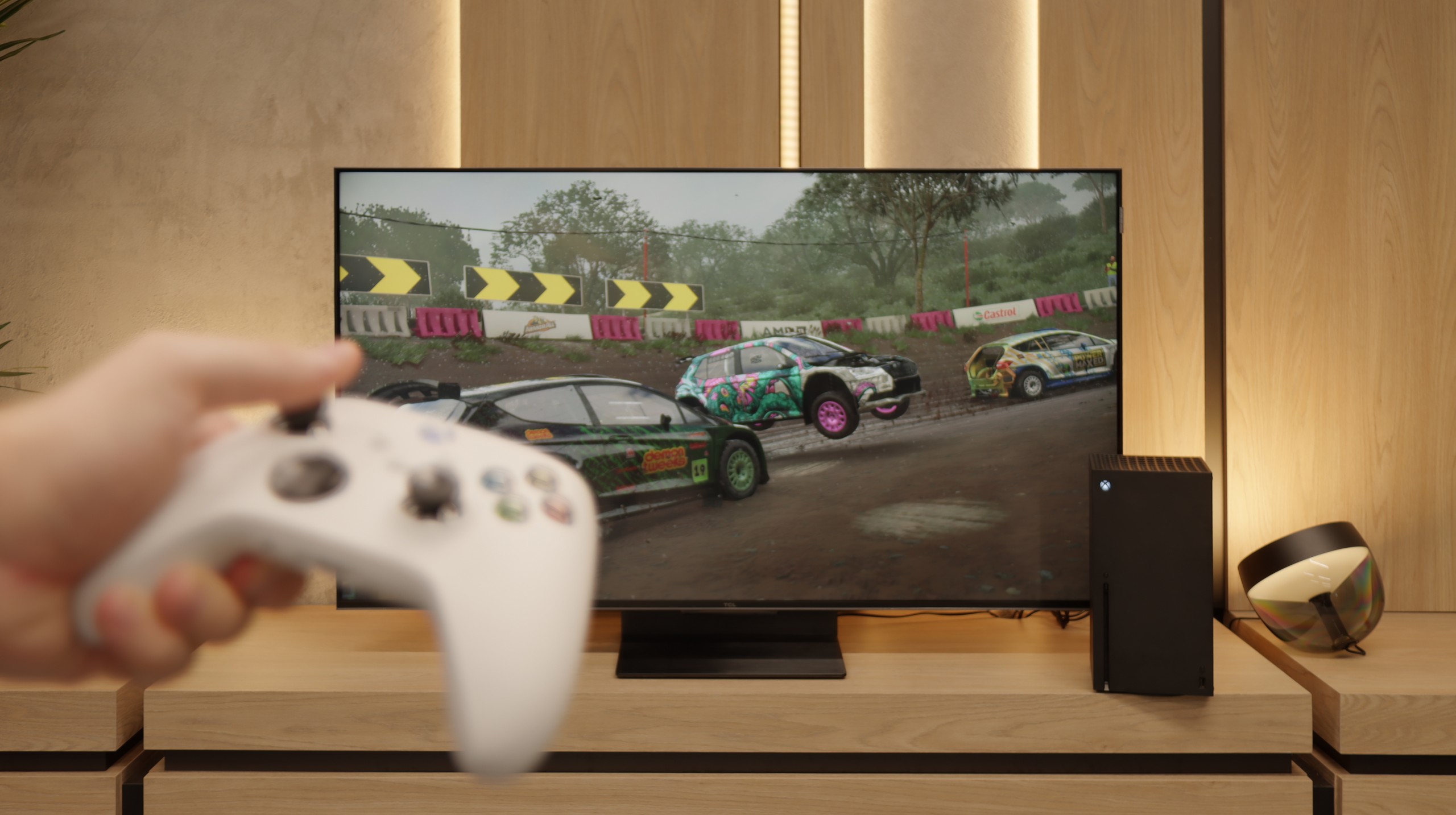
Philips OLED769 has been designed with gamers in mind, offering full compatibility with consoles and the highest quality of gameplay. The television received the maximum rating in this category, providing everything that the heart desires. With HDMI 2.1 ports fully supporting ALLM (Auto Low Latency Mode) and VRR (Variable Refresh Rate), the television ensures smooth and hassle-free gaming. ALLM automatically switches the television to low latency mode, while VRR eliminates stuttering and screen tearing, resulting in fluidity and stability in gaming. The Dolby Vision gaming feature is another advantage, although it only works at a frequency of 60 Hz. Most casual gamers will likely not feel the lack of a higher frequency; however, more demanding users may have some reservations. This allows for enjoyment of a dynamic range of tones and realistic images, enhancing the gaming experience. PC gamers will also not be disappointed, as Philips OLED769 offers full compatibility with Nvidia graphics cards, thanks to support for G-Sync. This technology synchronises the refresh rate of the television with the graphics card, eliminating tearing and stuttering, resulting in excellent image fluidity.
Philips OLED769 is a television that perfectly meets the needs of gamers, offering a wide range of advanced features and technologies that significantly enhance gameplay quality and user comfort.
The TCL C7K is a television that on paper appears to be the dream equipment for gamers – and most importantly, it holds up in practice too. To start with good news: there are two full-bandwidth HDMI 2.1 ports, so we can easily connect both a console and a computer, taking advantage of all their capabilities. The panel itself supports a refresh rate of 144 Hz, which gives a significant advantage in dynamic games. There is also a complete set of gaming features: VRR (variable refresh rate), ALLM (automatic low-latency mode), and support for Dolby Vision in games. There is also the HGiG mode, which allows for HDR effects consistent with the creators' intentions. GameBar, an information bar for gamers. It works quickly, looks clear (like a Nintendo console👌), and shows what matters most: the current frame rate, VRR status, and even HDR parameters.
Input lag
9.8/10
9.7/10
SDR
HDR
Dolby Vision
The input lag on the Philips OLED769 is truly impressively low. At a frequency of 120Hz, values hovering around 5 ms make a huge impression, and for a frequency of 60Hz, 13 ms is also an excellent result. Such low latencies ensure a quick response to player movements, which is crucial for smooth and responsive gameplay. The only thing that can be criticised is the lack of support for Dolby Vision at materials/games with a refresh rate of 120Hz. Nevertheless, the television still offers incredible visual experiences and excellent specifications that will satisfy any gamer.
When it comes to delays, the C7K gives no reason for complaints. In games at 120 Hz, input lag is around 10 ms, which means the television responds really quickly. And interestingly – even in Dolby Vision mode, the result is very similar, which is not always the standard. Good job, TCL. At 60 Hz, the lag does increase a bit, but that's completely normal and affects virtually every television with a refresh rate of 120Hz and above. The most important thing is that everything still runs smoothly and there’s no feeling that something is not responding to our actions.
Compatibility with PC
7.6/10
8.4/10

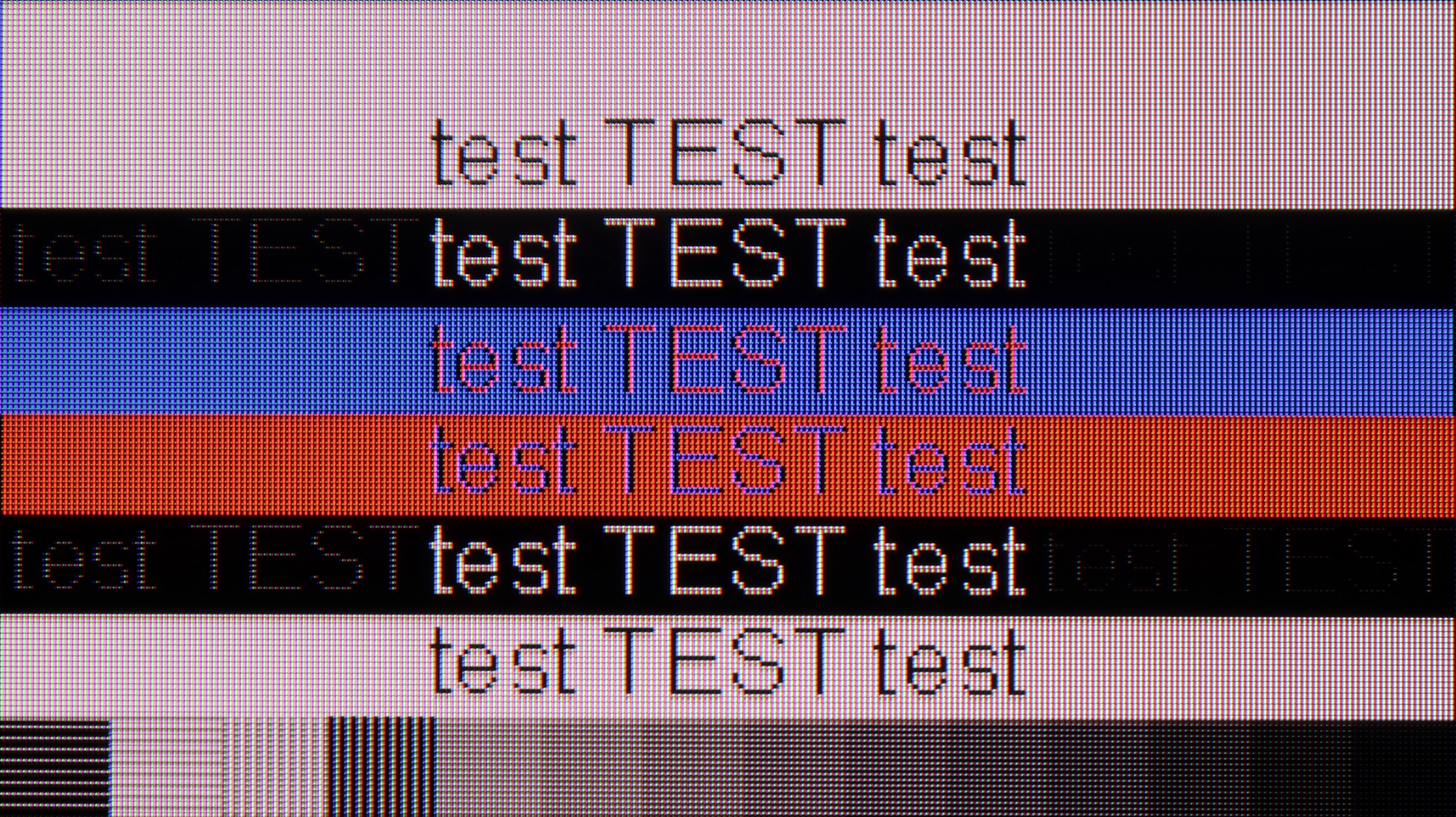
OLED769 performs excellently in collaboration with PCs. The rating in this category is very good, primarily due to the great readability of fonts, regardless of the background colour. The support for chroma 4:4:4 further enhances image quality, ensuring clear and sharp details. The low response time is another advantage of this model, which translates into smoothness and responsiveness during work and gaming. All of this makes the Philips OLED769 an ideal choice for PC users seeking a large screen with high image quality and excellent parameters.
If we are going to connect the C7K to a computer – especially for gaming – there is definitely a lot to play for. We have 4K at 144 Hz, which already sounds great, but if we lower the resolution, the television can even display up to 280 Hz. In e-sports, where every fraction of a second counts, this really makes a difference. On top of that, there is support for G-Sync and FreeSync, so regardless of which graphics card we have – the image will be smooth, without any stuttering or tearing.
However, if we plan to place the C7K on a desk and use it like a monitor, it’s a bit less "rosy." Yes, it supports chroma 4:4:4, so fonts should be sharp, but with very dark letters, there is slight blurriness and dimming of the edges. This is not something that immediately stands out during gaming or watching, but when working with text – it can be distracting. In everyday use – it’s probably nothing to worry about, but if we plan to place a 50-inch screen a meter from our face, it’s worth keeping this in mind.
Viewing angles
7.5/10
3/10
When it comes to viewing angles, Philips OLED769 performs excellently, as is the case with all OLED televisions. The image remains clear and does not lose quality regardless of the viewing angle. This means you can enjoy exceptional picture quality even when watching from the side or from more unusual locations in the room. The only televisions that offer even better viewing angles are those equipped with QD-OLED and OLED MLA panels. These technologies can provide even greater stability and image clarity from various angles. However, compared to standard LCD televisions, Philips OLED769 still offers significantly better viewing angles, making it a great choice for large rooms and family movie nights.
There are no surprises here – the C7K has classic viewing angles for a VA panel. That is: sitting directly in front – it’s excellent. The colours look good, the contrast is strong, everything is in place. But just shifting slightly to the side and it starts to get worse – the image loses saturation, blacks turn grey, and the overall impression diminishes a bit. So, if we plan to watch together with a few people or have a sofa that takes up half the living room – it’s worth seating everyone a bit more centrally. You can watch from the side, but don’t expect miracles – it’s simply a characteristic of VA panels.
TV efficiency during daytime
4.6/10
6.1/10




Matrix brightness
Average luminance SDR
TCL C7K / QM7K: 475 cd/m2
Philips OLED769: 258 cd/m2
The performance of the television Philips OLED769 during the day leaves something to be desired. The screen, although satin, moderately suppresses reflections, which can be noticeable in bright rooms. The low rating is primarily due to the rather average brightness of the television—250 nits is not impressive and may not be sufficient to ensure proper image quality in strong daylight. This makes viewing on sunny days potentially less comfortable, and the image details may be harder to discern.
Fortunately, the TCL C7K performs quite well in bright rooms. The applied panel has a satin finish that effectively suppresses reflections, which means we don't have to worry about lamp or window reflections even on sunny days. Importantly, the colours maintain their intensity and do not wash out, as can happen with weaker matte panels. In terms of brightness, the average for content like YouTube or regular television is slightly below 500 nits. This is not a record-breaking result – for example, the MQLED85 (C765) performs better in this regard. However, for everyday viewing during the day, it should work without major issues, provided we do not plan to place it opposite a south-facing window without curtains.
Details about the matrix
Subpixel Structure:

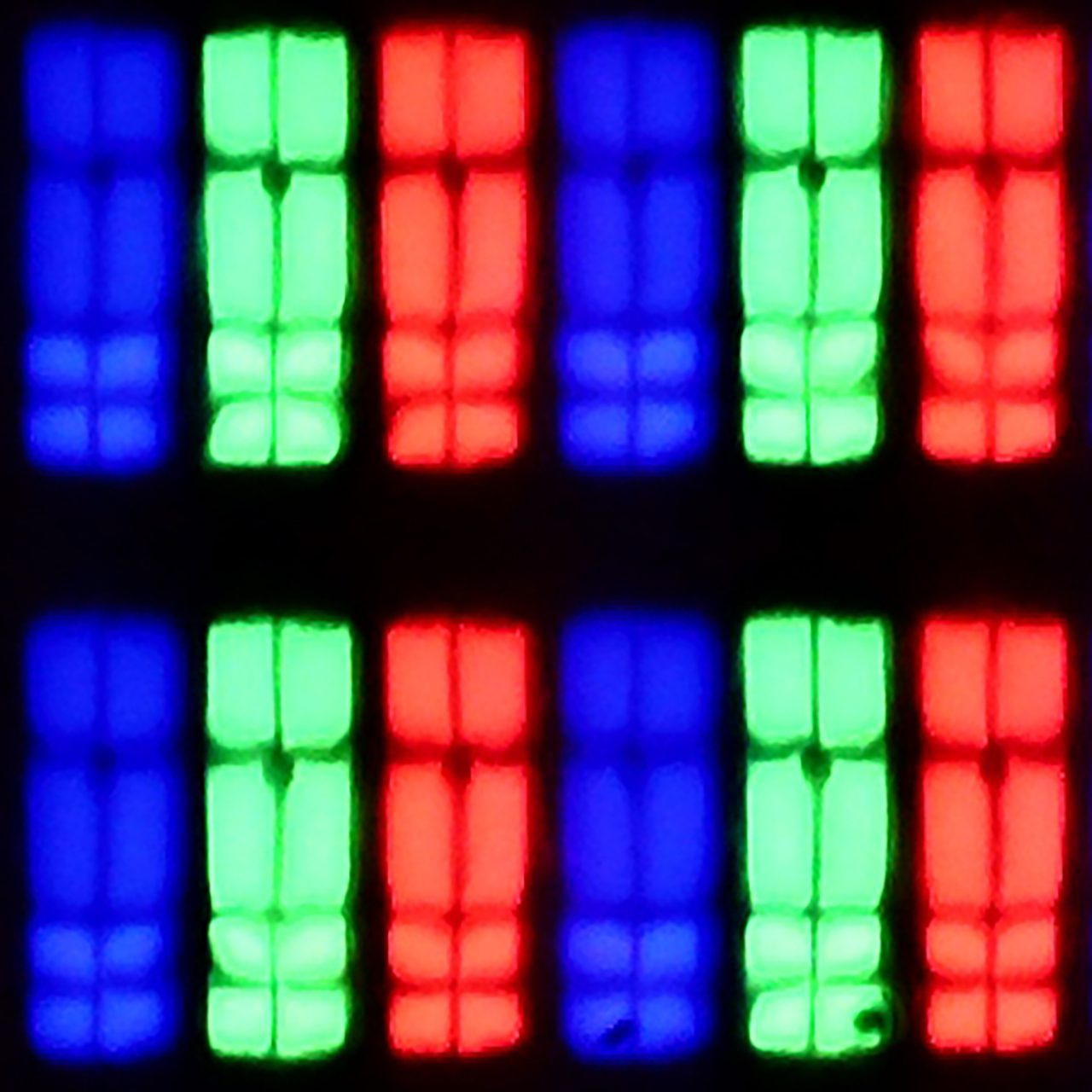
Panel uniformity:


Philips OLED769
TCL C7K / QM7K
TV features
5.5/10
7.7/10
- HDMI inputs0 x HDMI 2.0, 4 x HDMI 2.1 48Gbps2 x HDMI 2.0, 2 x HDMI 2.1 48Gbps
- OutputsToslink (Optical audio), eARC (HDMI), ARC (HDMI), Mini-Jack (Headphones)Toslink (Optical audio), eARC (HDMI), ARC (HDMI)
- Network InterfacesWi-Fi 2.4GHz, Wi-Fi 5GHz, Ethernet (LAN) 100MbpsWi-Fi 2.4GHz, Wi-Fi 5GHz, Ethernet (LAN) 100Mbps
- TV receptionDVB-T, DVB-T2, DVB-S, DVB-S2, DVB-CDVB-T, DVB-T2, DVB-S, DVB-S2, DVB-C
Classic features:
- Recording to USB (terrestrial TV)
- Recording programming
- Picture in Picture (PiP)
- RF remote control (no need to aim at the screen)
- Backlit remote control
- Teletext
- Audio only mode
- Possibility to connect Bluetooth headphones to the TV
- Possibility to simultaneously use Bluetooth headphones and the TV speaker
Smart features:
- AirPlay
- Screen mirroring (Windows Miracast)
- Wyszukiwanie głosowe
- Voice search in native language
- Ability to connect a keyboard and mouse

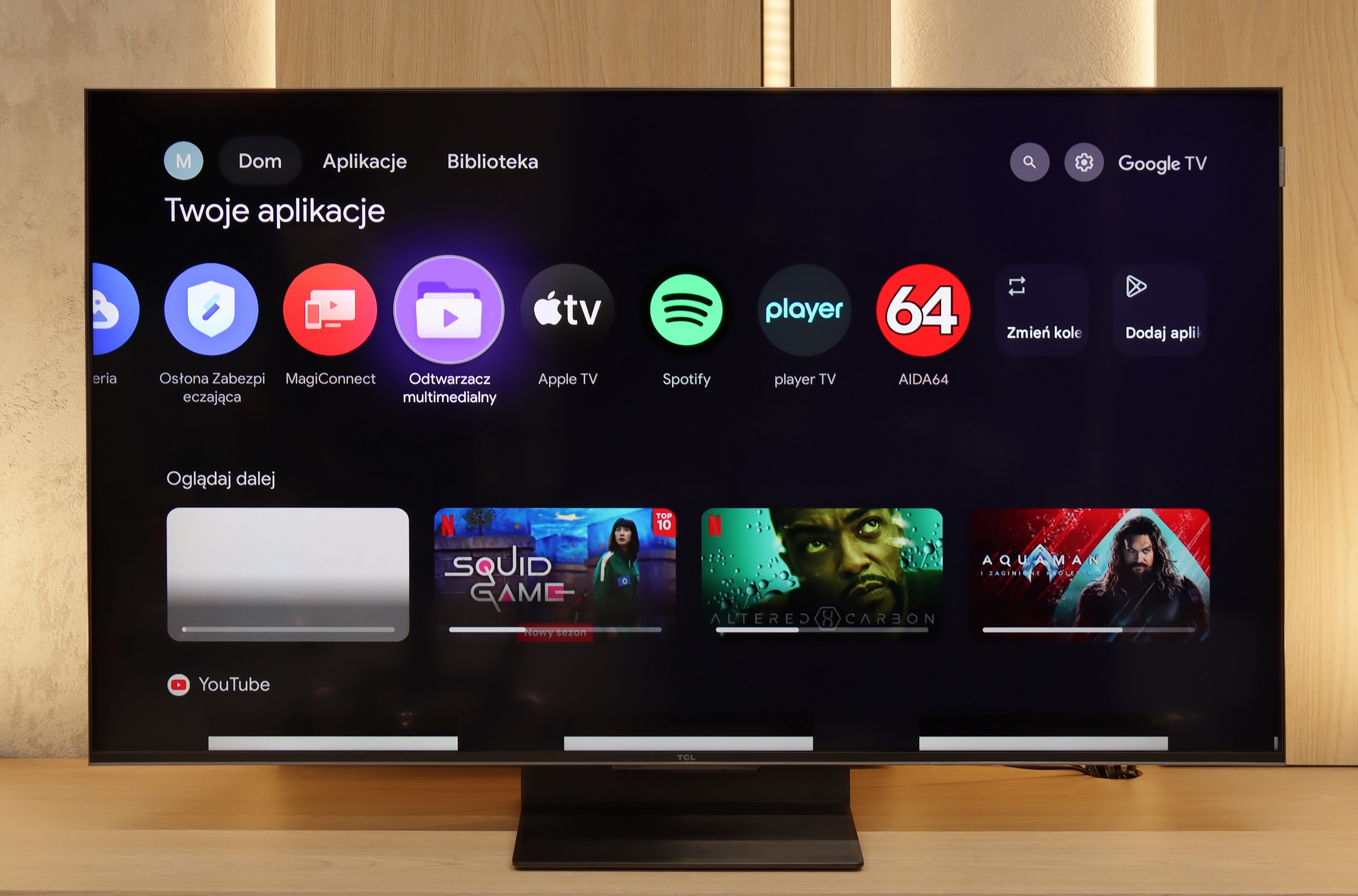
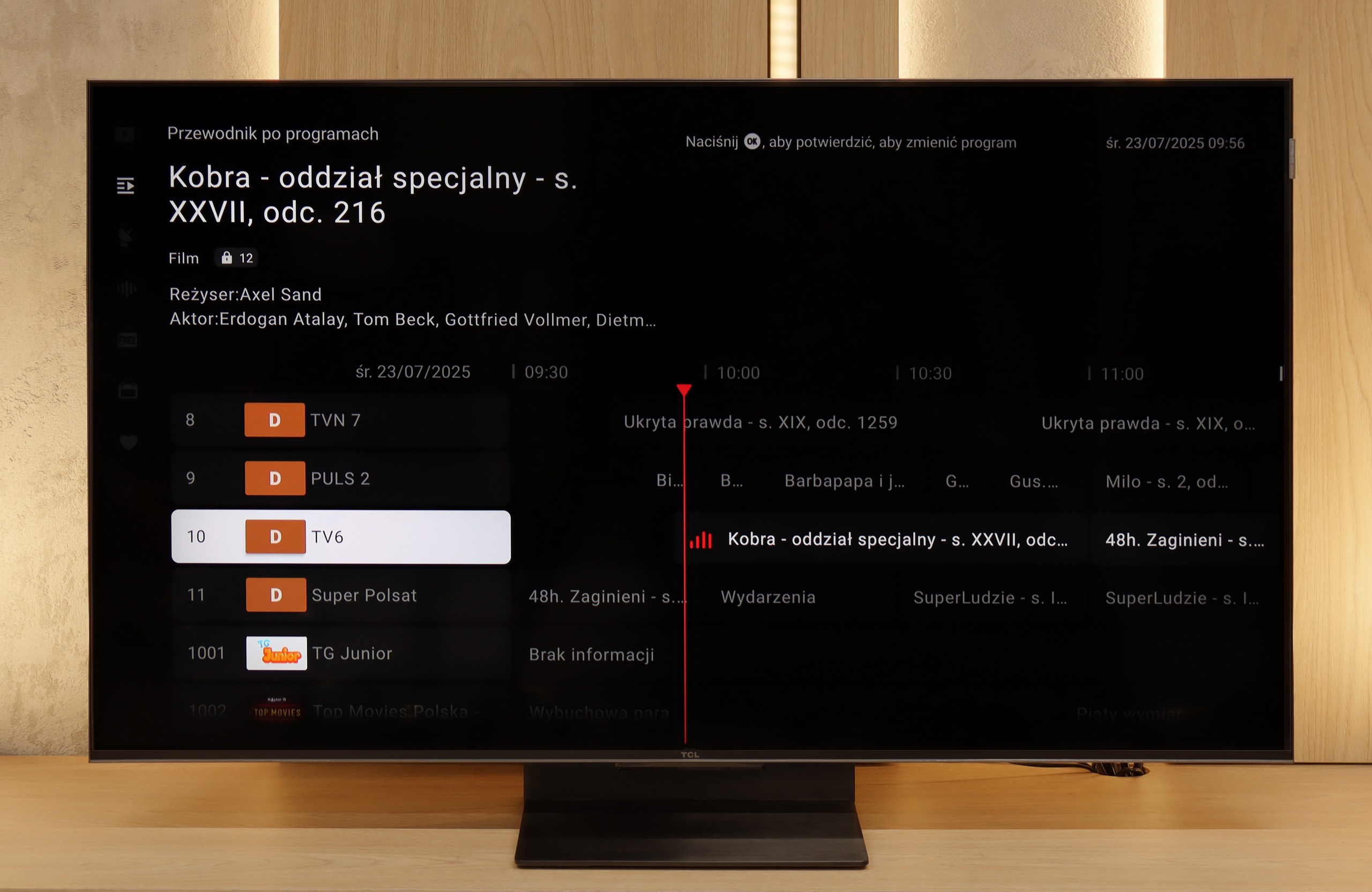
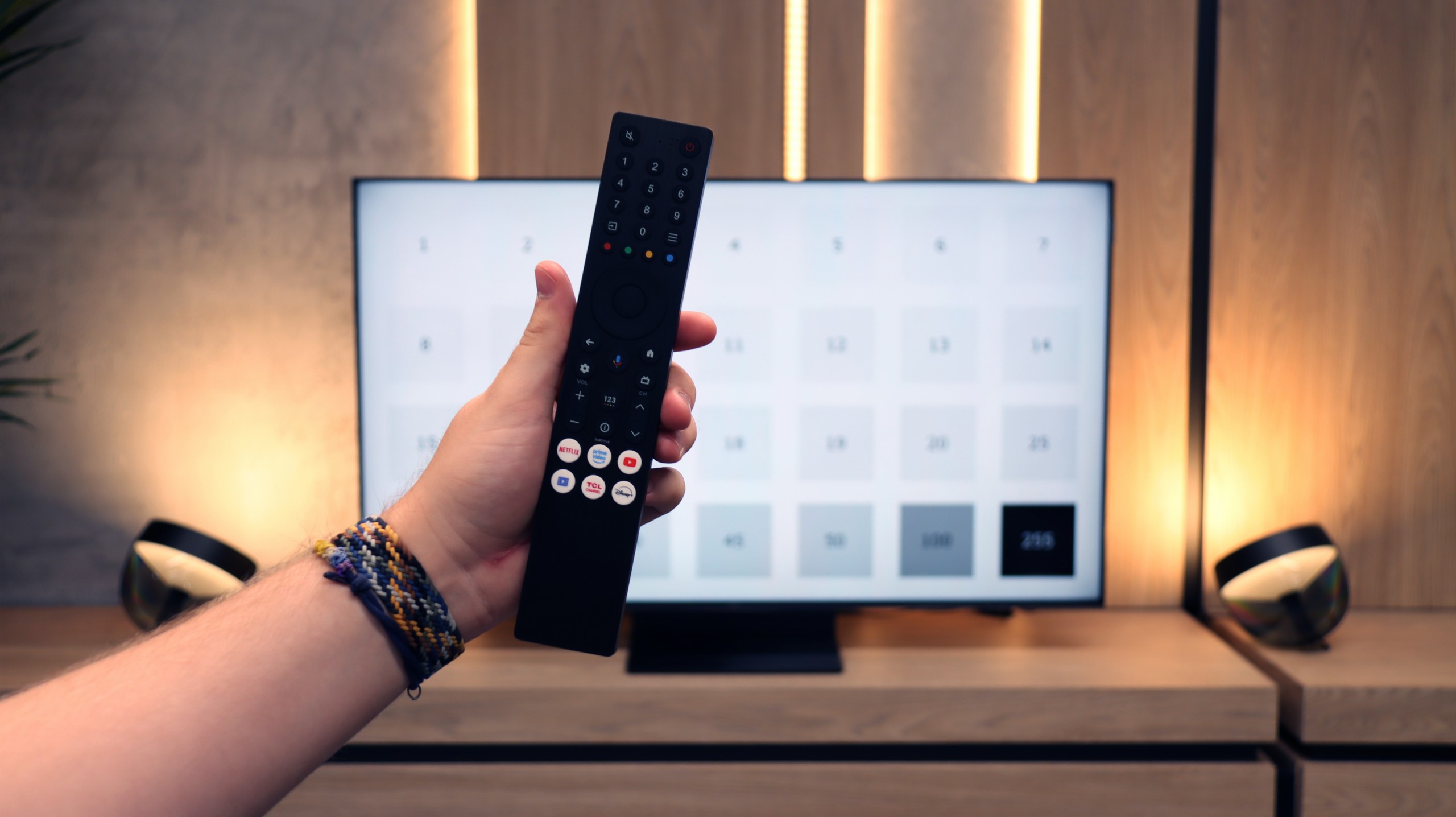
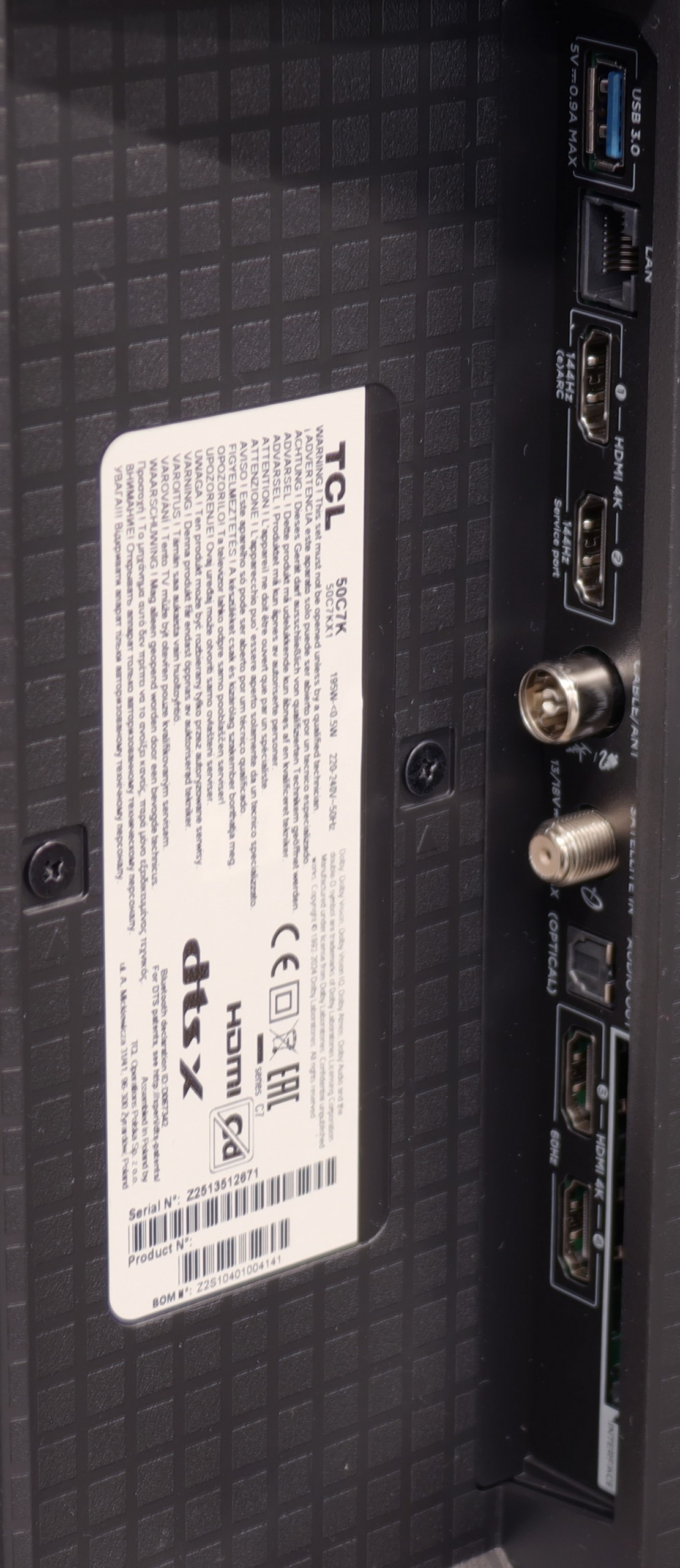
The greatest asset of the Philips OLED769 television is undoubtedly the three-sided Ambilight system. This technology truly makes a difference by extending the screen onto the walls around the television, creating the illusion of a larger screen. It not only enhances the visual experience but also adds a unique atmosphere, whether we are watching a film, playing games, or using other multimedia.
An interesting feature is the new remote control included with televisions operating on the TitanOS system. Its backlighting makes it very convenient to use, although its wireless functionality leaves something to be desired. Its hybrid design sometimes requires you to aim at the television screen, while at other times you do not, depending on which button you are using, which can be somewhat annoying.
In the context of the operating system, Philips has introduced a new strategy this year by replacing the previous open GoogleTV system with its own proprietary TitanOS. As is often the case with new technologies, TitanOS has its growing pains. At the moment, it only offers a few basic applications, and the app store does not impress with its variety. This may disappoint some users who expect a wide range of available applications. Additionally, the lack of support for AirPlay features and the ability to record onto USB are further limitations that could be problematic.
SmartTV: GoogleTV
The greatest strength of the TCL C7K in everyday use is undoubtedly the Google TV system. Thanks to it, we have access to an almost endless library of applications, including some more niche ones that are often unavailable on other platforms. The built-in Google Assistant understands Polish, so we can easily ask what’s on TV, what the weather is like, and even issue a few voice commands to control the television. The presence of Chromecast and AirPlay, which work smoothly and make life easier, is also a plus.
User Functions
On the downside, the classic features are somewhat lacking. Of course, we have the basics – teletext, EPG, and the ability to connect headphones – but that’s about it. There is no USB recording feature or picture-in-picture (PiP) mode, which can still be found among competitors. It’s also worth remembering that Google TV in the TCL edition can sometimes have strangely translated parts of the menu or minor errors in the interface. These are not things that interfere with daily use, but those sensitive to details may notice them.
Playing files from USB
8.2/10
9.2/10
Supported photo formats:
Maximum photo resolution:


The built-in player in Philips OLED769 generally performs well. Although it may lack support for unusual formats, which could pose a problem for specific users, most should be satisfied with the available options. The built-in player in the TitanOS system allows for the reading of Polish characters and the changing of font colour, which additionally makes everyday use easier. Thanks to these features, playing files from USB is comfortable and versatile.
The built-in file player in the TCL C7K performs really very well. It supports most of the most popular audio and video formats, so if we want to quickly plug something in from a USB drive and play it – there should be no problem. Of course, as is usually the case, we can find some minor shortcomings – not every exotic codec will work (Apple's HEIC), not all subtitles will be perfectly synchronised (txt.). However, the biggest advantage of this television comes to the rescue, namely Google TV. Thanks to access to the Google Play store, we can easily install an alternative player, e.g. VLC, and then no files will be a concern for us.
Apps
6.2/10
9.6/10














































Sound
6.7/10
7/10
- Subjective sound quality:6.7/107/10
- Dolby Digital Plus 7.1:
- Dolby True HD 7.1:
- Dolby Atmos in Dolby Digital Plus (JOC):
- Dolby Atmos in Dolby True HD:
- DTS:X in DTS-HD MA:
- DTS-HD Master Audio:
In the sound category, Philips OLED769 may not offer super dynamic sound, using speakers with a power of 2x10W. However, it is worth noting the support for all audio formats including Dolby and DTS. Thanks to this, despite the power limitations, users can enjoy high-quality sound with the help of external players.
To be honest, we didn’t expect much from the sound of the 50-inch version of the C7K model. Typically, in such sizes, it’s hard to get anything more than thin, flat sound. But here – a pleasant surprise. The audio proved to be really enjoyable, with good clarity and even a slightly discernible bass. This is probably related to TCL's new collaboration with the Bang & Olufsen brand, which is a novelty for 2025. Whether the C7K actually uses the original transducers from the Danish premium brand – we cannot confirm. But the end result still deserves a thumbs up. For a television without a soundbar – it sounds quite pleasant.


